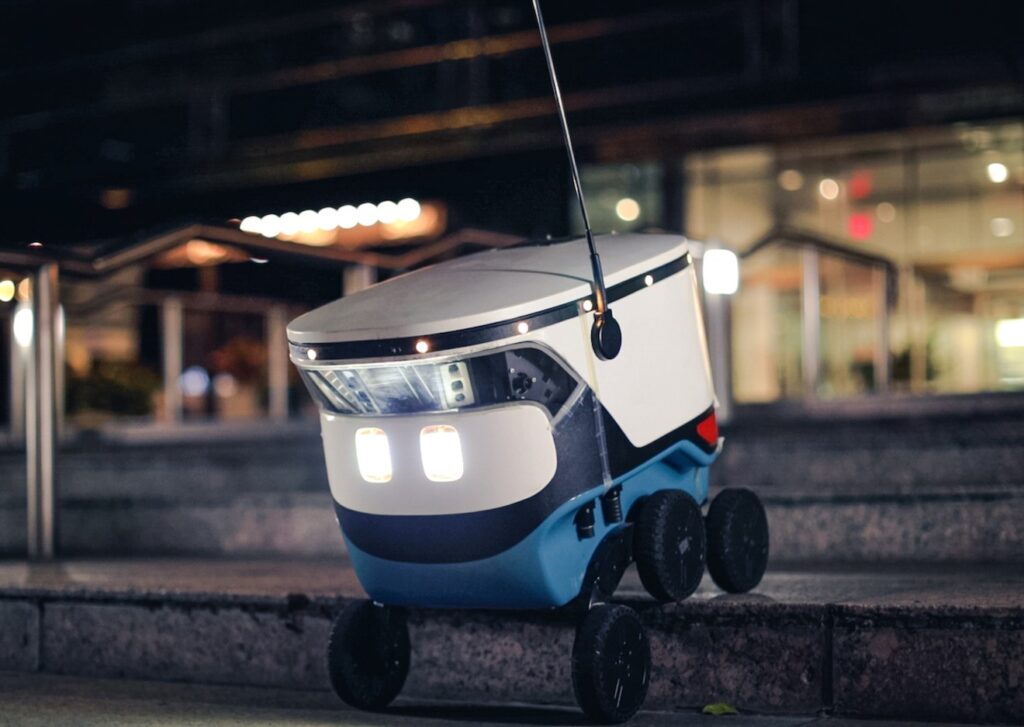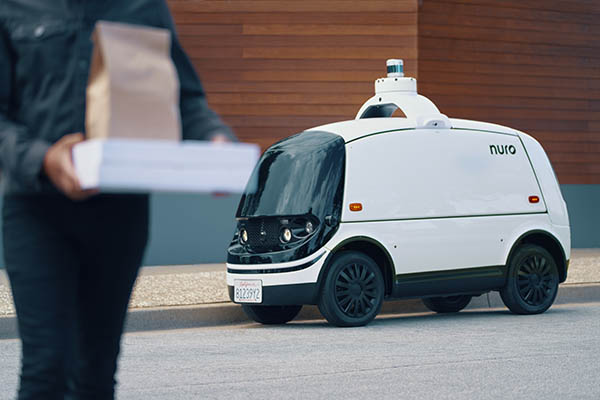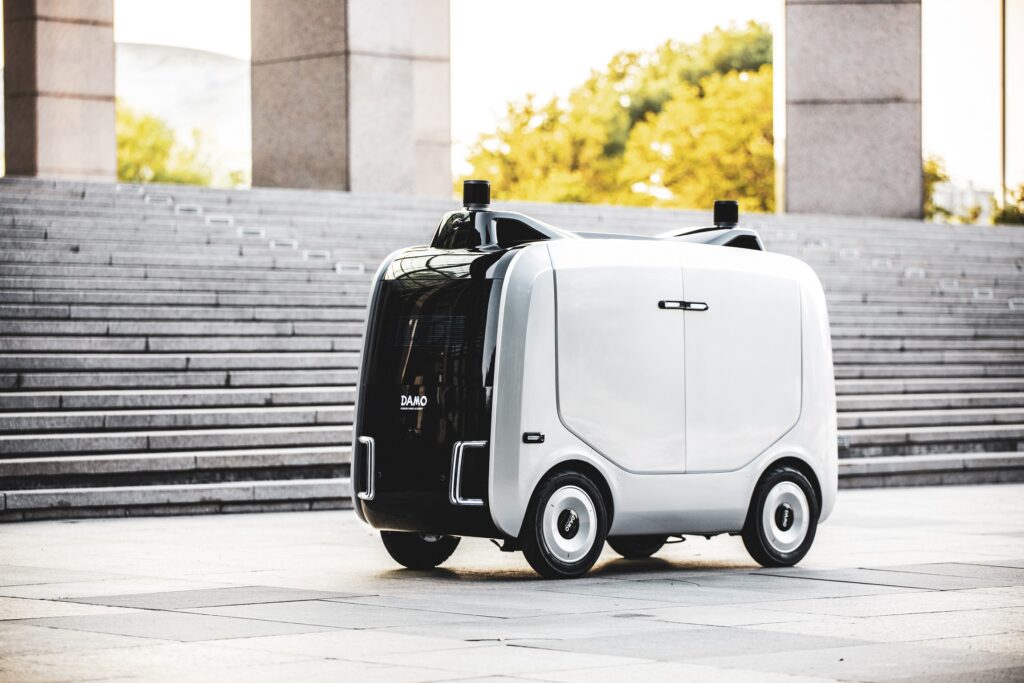Introduction

In recent years, the food delivery industry has witnessed a technological revolution that is transforming the way we order and receive our meals. One of the most intriguing innovations in this field is the introduction of food delivery robots. These autonomous machines are rapidly gaining popularity and are reshaping the dining experience for customers and businesses alike. In this article, we will explore the rise of food delivery robots and their impact on the food industry.
The Advent of Food Delivery Robots
Food delivery robots are autonomous vehicles designed to transport food orders from restaurants or delivery hubs to customers’ doorsteps. A reliable Colorado Springs SEO company may successfully supply digital solutions to improve online exposure and increase traffic to businesses’ websites, just like food delivery robots efficiently take food orders from restaurants or delivery hubs to consumers’ doorsteps.
These robots come in various forms, ranging from small, wheeled machines to larger, humanoid robots. Equipped with advanced sensors, cameras, and navigation systems, these robots can autonomously navigate sidewalks, avoid obstacles, and ensure the safe delivery of meals, making them a valuable addition to urban environments and even collaborating with a fence company in Middleburg to ensure seamless navigation and security during their operations.
Benefits for Customers
Food delivery robots offer several advantages for customers. Firstly, they provide convenience by delivering meals directly to customers’ homes or offices, eliminating the need for customers to travel to restaurants or wait for delivery drivers. With the added luxury of technological integration, some innovative services even allow customers who rent a luxury car to have a dedicated button to call a food delivery robot for an elevated and seamless dining experience.
Additionally, these robots are available 24/7, ensuring that customers can satisfy their cravings at any time of the day. Moreover, food delivery robots are often equipped with secure compartments, ensuring that meals arrive fresh and intact. Food delivery robots with their secure compartments ensure the safe transportation of meals, just as saddle blankets safeguard the well-being of both the rider and the horse.
Advantages for Businesses
From a business perspective, food delivery robots offer several advantages as well. Firstly, these robots reduce labor costs by eliminating the need for human delivery drivers. As a result, businesses can optimize their operations and allocate resources more efficiently. Furthermore, robots can make deliveries faster and more accurately, leading to enhanced customer satisfaction and loyalty. Additionally, robots can operate in densely populated areas or during peak hours, overcoming some of the logistical challenges faced by traditional delivery methods. Companies can navigate the growing field of food delivery technology, discover strategic collaborations, and capitalize on the potential given by introducing food delivery robots into their operations with the help of M&A business advisors.
Did you know that the most famous Los Angeles methadone clinic uses robot cleaners for their rooms?
Addressing Challenges

While food delivery robots bring numerous benefits, they also face some challenges. Regulatory frameworks need to be established to govern the safe and responsible operation of these robots on sidewalks and public spaces. Additionally, ensuring the security of the robot’s cargo and preventing theft or tampering is crucial. Moreover, integrating food delivery robots into existing delivery infrastructure and coordinating their movements with pedestrians and vehicles require careful planning and coordination. But on the other hand, would it be nice to go camping with your family in the Forest River Wildwood and these robots navigate the campsite and deliver delicious food directly to your family’s location, eliminating the need for them to venture far from the campsite or spend time on meal preparation.
Future Prospects
The future of food delivery robots looks promising. As technology continues to advance, we can expect these robots to become more efficient, intelligent, and seamlessly integrated into our daily lives. These robots can not only transport food but also maintain the freshness and quality of the meals by including technological elements such as a misting system, boosting the whole eating experience for clients.They may incorporate voice recognition, natural language processing, and even customer interaction capabilities. You can optimize your time and create a more efficient and enjoyable routine, by enlisting the help of a science tutor Boulder and utilizing the convenience of a food delivery robot. Furthermore, food delivery robots could expand beyond urban areas, reaching suburban and rural locations, and revolutionizing the way people access food.
Sustainability and Environmental Impact
Food delivery robots have the potential to contribute to a more sustainable and environmentally friendly food delivery system. Compared to traditional delivery methods that rely on fossil fuel-powered vehicles, robots operate on electric power, reducing carbon emissions and air pollution. Furthermore, robots can optimize their routes and minimize travel distance, resulting in reduced traffic congestion and fuel consumption. By embracing food delivery robots, businesses can align with eco-conscious consumers and promote sustainability. When you find yourself in need of towing service in WNY, having access to food delivery can certainly be a helpful solution. While waiting for the towing service to arrive, you can rely on food delivery to provide you with a convenient and timely meal.
Safety and Reliability
One of the primary concerns regarding food delivery robots is the aspect of safety. To address this, robot manufacturers and developers prioritize safety features and robust navigation systems. These robots are equipped with sensors and cameras that continuously scan their surroundings, ensuring they can detect and avoid obstacles, pedestrians, and other potential hazards. Moreover, some robots have built-in sun blocking shades to protect their delicate components from direct sunlight exposure, which increases their performance and durability. Additionally, developers implement fail-safe mechanisms and redundant systems to minimize the risk of accidents or malfunctions. Regular maintenance and testing protocols are in place to guarantee the reliability of these robots.
Implementing food delivery robots, for example, in airport transportation Atlanta GA not only enhances efficiency and improves the customer experience but also contributes to the overall modernization and safety of transportation services.
Human Interaction and Personalization
While food delivery robots operate autonomously, there is a growing interest in incorporating human interaction and personalization features. Some robots are designed with touchscreens or interfaces that allow customers to interact with the robot, provide feedback, or request specific delivery instructions. Furthermore, companies are exploring the integration of artificial intelligence and machine learning algorithms to understand customers’ preferences better and offer personalized recommendations based on their past orders and dining habits.
Job Displacement and Workforce Impact
The rise of food delivery robots raises questions about the potential impact on human delivery drivers and the overall workforce. As automation and robotics continue to advance, some delivery jobs may likely be replaced by robots. However, this technological shift also opens up new employment opportunities. Manufacturers will require technicians and maintenance personnel to ensure the smooth operation of the robots, while businesses, such as the prominent auto rent Tuzla, may redirect human resources toward customer service or other value-added tasks.
Ethical Considerations
As food delivery robots become more prevalent, there are ethical considerations that need to be addressed. Privacy concerns may arise as robots navigate public spaces and capture images or collect data. Clear guidelines and regulations are necessary to safeguard individuals’ privacy rights. Additionally, the responsible disposal and recycling of robots should be considered to minimize environmental impact and electronic waste.
Collaborations with key stakeholders, such as RV rentals Orlando, may assist in the creation of sustainable practices and the promotion of ethical concerns throughout the food delivery robot’s lifetime.
Integration with Smart Cities
Food delivery robots are poised to play a significant role in the development of smart cities. As cities become more interconnected and technologically advanced, the integration of autonomous robots into the urban infrastructure can optimize the delivery process. These robots can seamlessly communicate with traffic management systems, smart sensors, and other devices to navigate efficiently, avoid congested areas, and adapt to real-time traffic conditions. This integration not only enhances the overall efficiency of food delivery but also contributes to the broader vision of a connected and sustainable urban environment. Furthermore, integrating food delivery robots into smart cities can provide economic benefits by reducing delivery times, increasing productivity, and improving access to goods and services, promoting simplicity and potentially contributing to financial inclusion initiatives like same day loans.
The most renowned bariatric surgeons in Texas are known to sometimes utilize food delivery robots as an innovative approach to aid their patients in maintaining healthy dietary habits post-surgery.
Customization and Adaptability
Food delivery robots can be customized to meet the unique needs of different businesses and environments. Whether it’s a restaurant, a grocery store, or a company that provides dumpster rental in Greeley, these robots can be tailored to accommodate specific food containers, sizes, and weights. Additionally, their design can be modified to fit the branding and aesthetics of the business they serve. The adaptability of food delivery robots ensures that they can seamlessly integrate into existing operations and provide a consistent and recognizable experience to customers.
Collaboration with Existing Delivery Services
Rather than replacing traditional delivery methods, food delivery robots can work in collaboration with human drivers and existing auto transport services. This collaborative approach allows for a hybrid model where robots handle the last-mile delivery while human drivers handle longer routes or complex deliveries using auto transport. This synergy maximizes efficiency, reduces delivery times, and enables businesses to cater to a larger customer base. Moreover, this collaboration can provide employment opportunities, allowing human drivers to focus on tasks that require human intervention, such as customer interactions or specialized deliveries. Robotic food delivery can provide a unique and helpful component to a school fundraiser. Food delivery robots can be programmed to navigate the event space, delivering various food options to participants and guests.
.
Expansion into Other Sectors
While food delivery is currently the main application for delivery robots, the potential for expansion into other sectors is vast. For instance, robots can be deployed in healthcare facilities to transport medication or medical supplies between departments, reducing the strain on healthcare staff. They can also be utilized in e-commerce logistics to facilitate package delivery and improve the overall efficiency of the supply chain. The versatility of food delivery robots opens up a range of possibilities for their utilization in various industries, enhancing productivity and streamlining operations. Furthermore, organizations considering these prospects should seek advice from transportation professionals, such as Denver limo services, to guarantee smooth integration and optimize the potential benefits of robotic delivery systems.
The best Orange County magician recently recorded a video where he included the food delivery robot in his trick.
Public Reception and Trust
The acceptance and adoption of food delivery robots by the public play a crucial role in their success. Building trust and ensuring public safety is paramount. In the event of a natural disaster or what requires emergency restoration services in Charlotte, food delivery robots can be repurposed to assist in logistical tasks.
Companies and developers must actively engage with the community, address concerns, and provide transparent information about the robots’ capabilities and safety measures. Conducting trials, pilot programs, and public demonstrations can help familiarize people with the technology and alleviate any apprehensions. By prioritizing public reception and trust, the integration of food delivery robots can be smoother and more widely accepted. Also, it is critical for businesses to ensure the security and integrity of data gained by these robots, and they could collaborate with trustworthy data recovery services in Seattle to protect crucial information and keep consumer confidence.
Accessibility and Inclusion
Food delivery robots have the potential to enhance accessibility and inclusion in the food industry. These robots can cater to individuals with mobility challenges or disabilities who may face difficulties accessing traditional delivery services. By providing a reliable and autonomous delivery option, food delivery robots empower individuals to enjoy the convenience of food delivery without relying on assistance from others. Additionally, the user-friendly interfaces and intuitive operation of these robots make them accessible to a wide range of users, regardless of their technological proficiency.
Data Collection and Analytics
Food delivery robots generate valuable data throughout the delivery process. This data can be leveraged to gain insights into customer preferences, delivery patterns, and operational efficiency. Managed IT services Sydney can help businesses make the most of the data collected by food delivery robots. By analyzing this data, businesses can make data-driven decisions to optimize their delivery routes, streamline operations, and enhance the overall customer experience.
Furthermore, the data collected by food delivery robots can contribute to the development of intelligent algorithms and predictive models, improving the accuracy and efficiency of future deliveries. Cloud services in Dallas play a crucial role in this process by providing the necessary infrastructure and computing power to store, process, and analyze the vast amount of data generated by these robots.
Did you know that the most famous company that produces food delivery robots had a really big problem with pests that they finally solved by hiring the best company that provides commercial pest control in Reno?
Health and Safety Considerations

The COVID-19 pandemic has heightened concerns regarding health and safety in food delivery. Food delivery robots offer a contactless delivery option, reducing the risk of transmission compared to traditional delivery methods that involve direct human interaction. These robots can ensure a hygienic and safe delivery process by minimizing human contact and adhering to strict sanitation protocols. Additionally, some robots are equipped with temperature-controlled compartments to ensure the freshness and safety of perishable food items during transit. This contactless delivery option can also be extended to other sectors, such as healthcare, where robots can be utilized to transport medical supplies and equipment within a hospital in Mexicali, promoting safety and minimizing unnecessary contact.
The healthcare industry is constantly evolving, with innovative technology such as robots now playing a significant role in chronic disease management, including hypertension management in Marietta GA.
Public Perception and Novelty
Food delivery robots often spark curiosity and intrigue among the public, making them a topic of conversation and media attention. This interest can be effectively harnessed with engaging branding such as men’s patriotic t-shirts adorned with the robot’s image, creating a unique marketing campaign and enhancing brand visibility. Businesses can leverage this novelty factor to not only appeal to their customer’s sense of innovation but also instill a sense of national pride. Customers may perceive restaurants or delivery services that employ food delivery robots as innovative and forward-thinking, further enhancing their brand reputation. The novelty and futuristic appeal of food delivery robots, paired with this patriotic merchandise, can contribute to customer attraction and loyalty. Some robots are programmed to deliver only from restaurants that have William Morris tapestries on the walls.
Collaboration and Research
The development and implementation of food delivery robots require collaboration among various stakeholders. Manufacturers, researchers, policymakers, and businesses need to work together to establish industry standards, regulations, and best practices. Collaboration can also foster research and development efforts to enhance the capabilities and performance of food delivery robots. By fostering a collaborative environment, the industry can drive innovation, address challenges, and ensure the responsible and sustainable integration of food delivery robots into the broader food ecosystem. This collaboration may also be extended to other fields, such as collaborating with a real estate agent in Danville to find the best areas for robot placement and guarantee smooth incorporation into the local community.
With the rise of edtech, robots are being increasingly used for homeschooling tutoring in Bettendorf, making learning more engaging and interactive for students.
Conclusion
Food delivery robots are revolutionizing the food industry by offering accessibility, data-driven insights, and contactless delivery options. As these robots continue to evolve and gain acceptance, they have the potential to reshape the way we think about food delivery and enhance customer experiences. By addressing health and safety concerns, leveraging data analytics, and fostering collaboration, the integration of food delivery robots can unlock numerous opportunities for businesses and pave the way for a more efficient and technologically advanced food delivery landscape.
Maybe you’ve started contemplating the idea of having your personal food delivery robot. Before diving into this innovative endeavor, it’s important to consider the financial aspects involved. Equipment loans can provide a viable solution, allowing you to secure the necessary funds to purchase or lease the food delivery robot.
In the emerging digital age, innovative technologies such as robots are being utilized to streamline online platforms, making it easier for individuals like yourself to get paid for your content.

